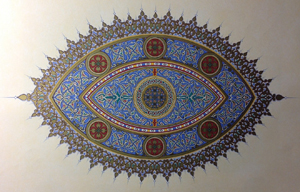Rumi's Masnavi, with Alan Williams
One-week Residential Seminar
Chisholme House
11–19 June 2016
A sample of writings by participants, presented in the Mead Hall on June 17th.
For all the writings download the pdf here.
– to Alan Williams
For days the sun was covered by a veil
no eye on earth could spy its radiance.
No mortal sight is able to discover
this Radiance which makes us see the cloud.
Our minds, composed of shadow and of light,
do not find here a meaning to uncover.
The Light which lights the light within our hearts
has never seen the cover of a veil.
O You, Who don’t discover ‘I’ in me,
To Whom I do not count as ‘you’, and yet
You’ve dressed Your Love as ‘You’ to ‘I’, so that
I could resolve in You without a trace.
How could Light know of ‘no trace’, ‘you’ or ‘I’?
Cover your lips! Don’t speak of ‘beyond Light’.
Rokus de Groot, Chisholme, June 17, 2016
Who am I?
Am I the symphony of the birds that I hear
whenever I wander among nature within and around us?
Am I this tree that come to my eyes
whenever I walk along the paths and roam over
the hills that surround us?
Who am I?
Am I the scent of wet land that I sense
when this body of mine steps out of the front door?
Is this smell the same that I carry within me
since childhood?
How can the scent of the south be
the same of the scent of the north?
Is it a sign that North and South, East and West
share the same essence?
Is it a sign that the “astrolabe of God's mysteries”
which interprets the stars that shine up high is
the same for the ones that shine within?
Who am I?
Am I the symphony of the birds, the tree, the scent of wet land
or the energy that shakes my heart whenever
I approach this place?
Am I this cloth that covers the kernel of my being?
What is this cloth made of?
Am I the layers of rust that obliterate the image
in the mirror of my existence?
Am I a part of the whole? Am I a whole within the Whole?
Am I the questions? Am I the answers?
Who am I?
What is this battered heart beating for?
Is it beating for the forms? Is it beating for the essence?
Can we find essence without
the helping hands of the forms?
What is this bruised being longing for?
Is it not longing for a lost scent of the core?
Is it not longing for the light that is hidden under
the meanderings of my soul that flow to the sea?
Is it not longing for the encounter of the rivers,
the Amazon, that exists within my being?
Is it not longing for the light within Light?
Is it not longing for communion with Thee?
Is it not longing for Silence?
Is this longing of mine... 'Yours'?
Who am I?
'You' know...
Luciana Lago, Chisholme 17 June 2016
Shaykh Jalaloddin sitting with adepts. British Library Manuscript Add. 27263 Masnavi-ye Mowlana Jalal al-Din Rumi Tabriz/Safavid c. 1530
Playlist: music studied to complement the readings
Alan Williams with the musicologist Rokus de Groot
The Flute (Naynâme)
- Nay (Iran): Hossein Omoumi, Shekofteh (CD Sarmast, Bâ Music Records BACD4, track 1)
- Ney (Turkey): Aziz Senol Filiz, Taksimi Hicaz (CD Sufi’s Voices, Asia Production, track 1)
- Bansuri (India): Hariprasad Chaurasia, Raga Bhairavi (CD to The Raga Guide, ed. J. Bor, Nimbus Records/Rotterdam Conservatory, 1999)
- Shakuhachi (Japan): Katsuya Yokoyama, Ko-kû (‘Vacuity’) (CD Japon, Ocora C580059)
- European flute: Claude Debussy (1862-1918), Syrinx
- European (alto) flute: Rokus de Groot (1947), Majnun’s Lament
Beginning
- Johann Sebastian Bach (1685-1750), Well-tempered Clavier I, Prelude 1, C major
- J.S. Bach, Well-tempered Clavier II, Prelude 3, D flat major
- J.S. Bach, Violoncello solo suite I in G major, Prelude
- J.S. Bach, Toccata, Adagio and Fugue in C major for organ, BWV 564
- Hariprasad Chaurasia, Raga Lalit (CD Golden Raga Collection, TDICL 005P)
Composition out of multiple contrasting segments (ending in ecstasy) Igor Stravinsky (1882-1971), Symphonies of Wind Instruments
Polyphony a. Heterogenic (all simultaneous voices different)
- J.S. Bach, Das Orgelbüchlein (The Little Organ Book), Nr 19 “Herr Gott, Nun schleuß den Himmel auf”, Nr 26 “Hilf Gott, daß mir’s gelinge”, Nr 40 “Ich ruf zu Dir, Herr Jesu Christ.
- J.S. Bach, Cantata BWV 131, Aus der Tiefe rufe ich, Herr, zu Dir,
nr. 2 “So Du willst, Herr, Sünde zurechten”,
nr. 4 “Meine Seele wartet auf den Herrn”
b. Models of European Polyphony:
Ockeghem (1410-1497), Obrecht (1457-1505), Josquin (1450/5-1521)
c. Segmental (alternation of contrasting segments) J.S. Bach, Himmelfahrts-Oratorium, Nr. 9 “Wenn soll es doch geschehen”. d. As ecstasy Perotinus Magnus (1160-1230), Organum “Viderunt Omnes”. e. Intercultural (Indian-European) Rokus de Groot, ShivaShakti (sarangi and alto oboe) (CD Quintone Q11002) f. Communal Aka polyphony (Pygmy, Central Africa)
Ecstasy (Endings)
- Anton Bruckner (1824-1896), Symphony 7, part 1
- Igor Stravinsky, Apollo, movement 1, “Birth of Apollo”, movement 10, “Apotheosis”
- Igor Stravinsky, Symphony in C, movement 4
- Igor Stravinsky, Symphonie des Psaumes (Symphony of Psalms), part 3
Drunkenness Sufyana Musiqi (Kashmir), Maqam Pahalvi, Zaval (CD New Samarkand Records, samcd9005)
Ending (in Silence)
- Igor Stravinsky, Les Noces (The Wedding)
- Igor Stravinsky, Requiem Canticles

Alan Williams delivers The Beshara Lecture 2016
at Chisholme House, 19 July 2016
Read more